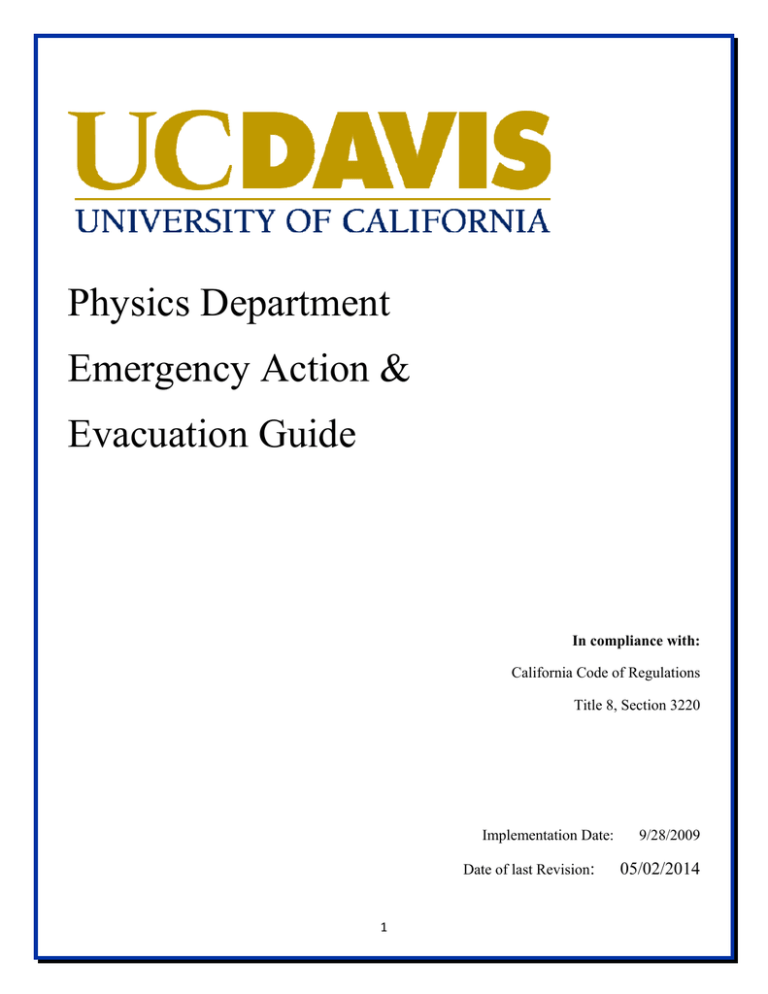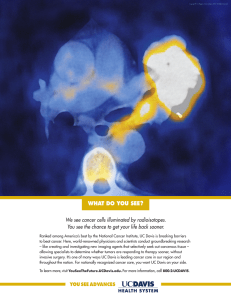Physics Department Emergency Action & Evacuation Guide
advertisement

Physics Department Emergency Action & Evacuation Guide In compliance with: California Code of Regulations Title 8, Section 3220 Implementation Date: Date of last Revision: 1 9/28/2009 05/02/2014 Introduction An Emergency Action & Evacuation Plan (herein referred to as an EAP) covers designated actions employers and employees must take to ensure employee safety from emergencies. Cal-OSHA regulations require employers to establish, implement and maintain an EAP. The program must be in writing and include the following elements: The preferred means of reporting fires and other emergencies A system to alert and notify employees of an emergency Evacuation procedures and emergency escape routes Procedures for employees who remain to operate critical plant operations before they evacuate A procedure to account for all employees after an emergency evacuation is completed Rescue and medical duties for those employees who are able to perform them Names or regular job titles of persons or departments who can be contacted for further information or explanation of duties under the plan How to Complete This Plan Successfully: This document includes a template for creating a departmental EAP, as well as additional incident and emergency response training that should be incorporated into the annual training for the EAP. As you read through the document, click on the gray shaded areas and type in the information requested. Example: Enter Department Name This template was designed to help the Department Safety Coordinator (herein referred to as “DSC”) create an EAP, with the understanding that not all departments will have the same structure or protocols during an emergency. As the creator of your department’s plan, you have the flexibility to adjust it to fit your needs to best assure the safety of your colleagues in an emergency. EAPs are often lengthy documents filled with explanations of the intended actions of every conceivable building occupant. When an event actually occurs, such plans are seldom used efficiently for three reasons: 1) people lack knowledge of the plan, 2) people do not understand the plan, or 3) the plan fails to address the varied physical locations where it must work. In order for your EAP to be successful, there are essential elements that need to be implemented. These essential elements are detailed on page 8, Responsibilities of the Department Safety Coordinators. If you have questions or suggestions regarding this document, please direct those to: Diana Cox dicox@ucdavis.edu 2 Contact Information This EAP has been prepared for the UC Davis Physics Department. The plan complies with the California Code of Regulations, Title 8, Section 3220. Physics Department (Office Name) Physics Building (Office Location) (530) 752-1500 (530) 752-4717 (Phone) (Fax) Andreas Albrecht (530) 752-5989 ajalbrecht@ucdavis.edu (Director/Dean/Chairperson) (Phone) (email) Peter Klavins (530) 304-3881 pklavins@ucdavis.edu (Department Safety Coordinator) (Phone) (email) Brian Barnett (530) 752-0679 barnett@physics.ucdavis.edu (Alternate Safety Contact) (Phone) (email) This Emergency Action & Evacuation Plan will be reviewed annually in: 3 March Emergency Protocols-Alert and Notification Reporting Emergencies: In the event of an emergency, UC Davis employees should contact UC Davis Dispatch by dialing 9-1-1 from a land line or a cell phone. You should call 9-1-1: In the event of a medical emergency To report all fire incidents, even if the fire is extinguished To report criminal or suspicious behavior If you are in doubt about the seriousness of a situation, such as any possible situation that you believe may be serious and that may result in injury, death, loss of property, apprehension of a suspected criminal or prevention of a crime that is about to occur. You should immediately alert the UC Davis Fire Department of any extinguisher usage. Provide the following information to UC Davis Dispatch upon calling Who you are Whether you are in a safe location What the nature of the emergency is Where it is located When it happened How it happened Alert and Notification of Employees: If an emergency calls for an evacuation or employees to take action, there needs to be a system in place to notify them. Emergency alert and notification of employees should be multi-layered, as systems can fail. A variety of methods are available, though not all systems apply to every building on the UC Davis campus, including: Audible alarm Examples of notification methods include: fire Visual alarms/signals alarm system, PA system, phone tree, bullhorn, Verbal notification even just flashing the lights can be a way to let UC Davis WarnMe people know there is an emergency happening. Via other electronic media The methods of alert and notification of employees in this department are: Primary Method: Fire alarm system Additional notifications: Verbal notification/e-mail notification 4 Emergency Protocols-Evacuation Evacuation Procedures & Routes Many incidents (e.g. building fire, police response) could require an evacuation of all or part of the campus. All employees must evacuate the building when notified to do so. Please refer to Policy & Procedure 390-10 for more information on Campus Emergency Policy. Prior to Exiting After being notified to evacuate, stop all work activities and evacuate immediately. Close, but do not lock, the doors (locked doors can hamper rescue operations). Remember that you may not be allowed back into the building for an extended time. Evacuation Routes/Exiting the Building During an emergency evacuation, use the nearest door or stairway if available. Each employee needs to be aware of at least two exit routes in their main building in the event one is compromised. All campus buildings over one story high must have building evacuation signs posted on every floor. The signs must be posted at all stairway and elevator landings and immediately inside all public entrances to the buildings. More information on this is available in the FireNet Emergency Evacuation Signs. Persons involved with developing the EAP need to address how to evacuate colleagues with special needs that are unable to evacuate on their own. More information and guidance on this topic can be found in the FireNet Guidelines to Emergency Evacuation Procedures for Employees/Clients with Disabilities. Assembly Area After exiting the building, all employees, students, volunteers, and visitors should follow the evacuation route to the pre-arranged assembly area. Assembly Area Guidelines have been developed to help DSCs choose the safest location to assemble. The Department Chair should assign an Assembly Area Manager to each evacuation location. List all buildings in which department members are assigned space and the corresponding assembly areas and manager. Physics Building North side of Building Peter Klavins Roessler Hall East side of Building Brian Barnett EPS Building West side of Building Brian Barnett 5 All employees should stay within your respective group at the Assembly Area. No one should leave the area until notified by the First Responders, Assembly Area Manager, or Responder Liaison. Assigned Job Responsibilities Assembly Area Manager Duties: It is recommended that the senior employee or their designee acts as the Assembly Area Manager. The Assembly Area Manager should be responsible for taking roll call and therefore it is imperative that prior to an emergency the Department Safety Coordinator (DSC) and Assembly Area Manager work together to ensure an updated employee roll call sheet is available and accessible at the time of the emergency. Ideally, the person responsible for roll call will take a personnel list (use attached form or alternate) before leaving the building. The Assembly Area Manager should report any injuries in need of immediate care to First Responders. Any other minor injuries should be documented and reported through the proper chain of command to the Physics Department Chairperson. The Assembly Area Manager is responsible for sharing information as it becomes available to the evacuated persons. The Assembly Area Manager should not leave the assembly area; therefore it is suggested the Assembly Area Manager assign a liaison to the First Responders. Responder Liaison Duties: The Responder Liaison ensures important communication and information exchange between the First and Second Responders (e.g. Fire, Police, Facilities), and the Area Assembly Manager. The Responder Liaison (whom may be the DSC if present) is responsible for informing the on-scene Incident Commander of the status of department employees and visitors. Responder Liaisons should be prepared to provide the following information (if known) Nature of the emergency (e.g. fire) Location of the emergency Number of persons trapped Number of persons hurt Number of persons unaccounted for If needed, the Responder Liaison should recruit volunteers to help direct and contain evacuees to the Assembly Area. After a major incident, building occupants may not re-enter buildings until cleared by a campus official. Procedures for Employees Who Remain to Operate Critical Operations Safety is a top priority at UC Davis, and there are no critical operations worth risking one’s welfare to perform. If you believe your department has critical operations requiring an employee(s) to remain in the building during an evacuation (most departments will not), please contact Diana Cox to develop this section of the plan. 6 Rescue & Medical Duties UC Davis relies on the UC Davis Fire Department and partnering agencies to provide rescue and medical duties. It may be useful to document employees in your department who have specialized medical training. The department does not have employees with specialized medical training. The individuals listed above should not practice outside of their scope of their training and are not expected or required to assist in any emergency or medical situation. Responsibilities of the Department Safety Coordinator The Physics Department Safety Coordinator or designated individual is responsible for implementing essential elements including planning, evaluating, and implementing the EAP. The following duties must be performed to maintain an effective EAP: Review and update the EAP annually or as needed. Update and submit the Emergency Call List to the UC Davis Dispatch Center. Train employees on the location of emergency exits, fire extinguishers, manual pull stations, first aid kits, and AEDs if applicable. Ensure evacuation routes are posted and walkways remain clear at all times. Train employees annually on the EAP, including the “Additional Training” sections. Ensure all new hires are familiar with the procedures and a copy of the plan is made available. Document all training. Train the Assembly Area Managers, Responder Liaisons, and Alternate Department Safety Contact. Confirm they understand their duties as assigned in the plan. Exercise your department’s EAP annually. It is recommended you exercise your plan in the following order: 1. Conduct a Tabletop Exercise. This will allow departments to use their training on the EAP, as well as to work through any inefficiencies prior to an emergency. Contact Diana Cox for training or assistance with your tabletop exercise. 2. Schedule a Building Evacuation. The UC Davis Fire Department can perform a limited number of building evacuations each month. Advanced notice and coordination between the departments that share your building before the exercise is critical. The Fire Department will not conduct the exercise if coordination between department DSCs has not occurred. Please contact your Department Safety Advisor to schedule an exercise. Evacuations will be scheduled on a first come first serve basis and times and dates will be decided based on the Fire Department’s availability 7 9 10 11 12 13 14 15 Roll Call Sheet Physics Department Office Location: Room 225 Physics Building The Physics Department Safety Coordinator or designated individuals are responsible for maintaining a current list of personnel in the department. This form can be used, or, if your department currently has a directory, you can format it into a roll sheet with room and building location and attach it to the EAP. Assembly Area Managers and DSCs should have a copy to complete roll call during an emergency. An updated directory is maintained on the Physics Department website: http://www.physics.ucdavis.edu/people/everyone.html http://www.physics.ucdavis.edu/phonelist.php http://www.physics.ucdavis.edu/researchers.php 16 Additional Training: Communications for Campus-Wide Emergencies In the event of a major emergency, there are multiple ways to distribute life-saving and other important information. Familiarize the individuals in your department with these communication methods: Check the University homepage www.ucdavis.edu UC Davis posts information about emergencies and other major news on its home page at www.ucdavis.edu. News can also be found at www.news.ucdavis.edu. Call the Emergency Status Line (530) 752-4000 The Emergency Status Line provides a recorded telephone message about the status of the Davis campus in an emergency. It indicates the emergency’s nature and provides brief instructions. Listen to the News Media UC Davis works with the news media to share information about emergencies and provide direction to the university community. AM radio KFBK 1530 initiates public Emergency Alert System messages for several area counties. The station offers live audio streaming at www.kfbk.com Become a “Fan” on Facebook UC Davis sends emergency bulletins to its “fans” on Facebook. If you aren’t already a member, join Facebook at www.facebook.com. Then you will be able to visit UC Davis’ Facebook site and click through to become a fan. Sign up for Personal Alerts through the WarnMe system This emergency notification service provides students and employees with timely information and instructions during emergencies. UC Davis WarnMe sends alerts by email, telephone, cell phone and text messaging. To deliver messages, WarnMe uses employees’ work contact information from the university’s online directory, students’ email addresses and personal contact information you voluntarily provide. Register and update your information at http://warnme.ucdavis.edu. It is important to understand that you will not be notified of every incident that UC Davis Police or Fire responds to. In a campus-wide emergency, communications may be sent out one or all of the ways listed above and will vary depending on the incident. 17 Additional Training: Sheltering-in-Place One of the instructions you may be given in an emergency is to shelter-in-place. Shelter-in-place is used mainly for hazardous materials incidents and sustained police action, or when it is more dangerous to venture outside than to remain indoors in your current location. This means you should remain indoors until authorities tell you it is safe or you are told to evacuate. The following are guidelines that should be shared with your department’s employees. General Guidelines on how to Shelter-in-Place Select a small, interior room, with no or few windows, ideally with a hard-wired telephone (cellular telephone equipment may be overwhelmed or damaged during an emergency). Close and lock all windows and exterior doors. Review your EAP, inspect your workplace emergency kits if you have them. Do not exit the building until instructed to do so by campus officials. Check for status updates using the resources detailed in the section, “Communications for Campus Wide Emergencies." Specific for a Hazardous Material Incident Turn off all fans, heating and air conditioning systems If instructed, use duct tape and plastic sheeting (heavier than food wrap) to seal all cracks around the door and any vents into the room If you are in your car, close windows and turn off vents and air conditioning In an incident requiring you to shelter-in-place, it may take several hours before it is safe to leave your building. It is important to have food and water in your office or work location to last a minimum of 24 hours, and preferably up to 72 hours. Having a workplace preparedness kit is easy to make and a good idea. 18 Additional Training: Community Survival Strategies for an Active Shooter The UC Davis Police Department hosts workshops to the members of the campus community presenting strategies to increase the likelihood of surviving an active shooter. The workshop covers five steps for increasing your chances of surviving an active shooter and also provides demonstrations for attacking the attacker. Presentations run approximately 90 minutes including a question/answer session, but it is recommended departments allow 2 hours release time for employees, as there is a hands-on component at the end of the presentation. Community presentations are available on the Davis and Sacramento campuses throughout the year. To schedule a workshop please contact: Lt. Matthew Carmichael (530)752-5350 mecarmichael@ucdavis.edu In the training, Community Survival Strategies for an Active Shooter participants should be aware that the presentation deals with a very sensitive subject and uses actual audio tape from the 9-1-1 call at the Columbine shootings. Participants will also have the opportunity to see different types of firearms and should be prepared to hear what an actual gunshot sounds like. 19 Training Sign-in Sheet **All Employees need to have documented training ** Training Topic: Emergency Action & Evacuation Plan Date: _____________ Instructor/Trainer: _________________________________ 1. __________________________________________________________________ 2. __________________________________________________________________ 3. __________________________________________________________________ 4. __________________________________________________________________ 5. __________________________________________________________________ 6. __________________________________________________________________ 7. __________________________________________________________________ 8. __________________________________________________________________ 9. __________________________________________________________________ 10. __________________________________________________________________ 11. __________________________________________________________________ 12. __________________________________________________________________ 13. __________________________________________________________________ 14. __________________________________________________________________ 15.__________________________________________________________________ 16.__________________________________________________________________ 17.__________________________________________________________________ 18.__________________________________________________________________ 19.__________________________________________________________________ 20.__________________________________________________________________ 20




